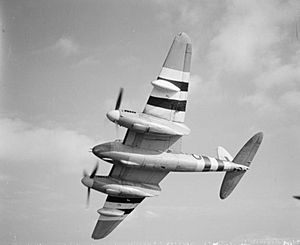No. 248 Squadron RAF facts for kids
Quick facts for kids No. 248 Squadron RAF |
|
|---|---|
| Active | August 1918 - 6 March 1919 30 October 1939 – 30 September 1946 |
| Country | |
| Branch | |
| Motto(s) | French: Il faut en finir ("It is necessary to make an end of it") |
| Insignia | |
| Squadron Badge heraldry | A demi-sword in bend partly withdrawn from the scabbard. |
| Squadron Codes | WR (Oct 1939 - Oct 1943) DM (Oct 1943 - 1945) |
No. 248 Squadron was a special group of planes and pilots in the Royal Air Force. This squadron was active right after World War I and then again during World War II. They played important roles in protecting the UK and fighting enemies.
Contents
No. 248 Squadron RAF: A History
Early Days: World War I
No. 248 Squadron RAF started in August 1918 at RNAS Hornsea Mere in East Riding of Yorkshire. It was formed by combining three smaller groups of seaplanes.
The squadron used planes called Short 184 and Fairey Hamble Baby. These were floatplanes, meaning they could land and take off from water. Their main job was to fly patrols looking for enemy submarines off the Yorkshire coast.
They continued these important patrols until World War I ended in November 1918. The squadron was then officially closed down on March 6, 1919.
World War II Missions
Reforming for War
The squadron was brought back to life after World War II began. It reformed at RAF Hendon in October 1939 as a Night Fighter squadron. This meant they were trained to fight enemy planes at night.
In December 1939, they received their first planes, Bristol Blenheim IFs. These were fighter versions of a light bomber plane. Soon after, in February 1940, they joined Coastal Command. They moved to RAF North Coates and got newer Blenheim IVFs.
Protecting the Coasts
The squadron flew fighter patrols over the North Sea from places like RAF Dyce and RAF Montrose. Their job was to protect the skies and ships. In July 1940, they moved to RAF Sumburgh in the Shetland Islands. From there, they flew missions to gather information and attack enemy ships off the coast of Norway.
In January 1941, they returned to Dyce. They started escorting convoys, which are groups of ships traveling together for safety. They also continued their reconnaissance missions, looking for enemy activity.
New Planes and New Tasks
In June 1941, the squadron moved to RAF Bircham Newton. In July, they received new, powerful planes called Bristol Beaufighters. Their first mission with these new aircraft was on August 14.
They protected convoys and attacked enemy ships off the Dutch coast. A part of the squadron also went to Cornwall. There, they flew long-range fighter patrols over the Western Approaches, which are the waters west of Great Britain.
In February 1942, they moved back to Dyce. They continued patrols and helped escort Bristol Beaufort torpedo bombers attacking targets in Norway.

Fighting Over the Bay of Biscay
In July 1942, the squadron went to Malta. They provided long-range fighter support for a big convoy called Operation Pedestal. They also attacked airfields in Sardinia and a convoy near Corfu. After these missions, they returned to the UK, leaving their planes behind.
Back in the UK, with new Beaufighters, they patrolled the Western Approaches and the Bay of Biscay. Their special job was to fight German Junkers Ju 88 fighters. These German planes were attacking Allied anti-submarine aircraft. Many battles happened in 1943. The squadron received even better Beaufighter Xs in June 1943. They also started attacking enemy ships and had a small group of planes based in Gibraltar.
The Mighty Mosquitos
In December 1943, the squadron began to get de Havilland Mosquito FB VI fighter-bombers. They flew their last Beaufighter missions in January 1944 and started Mosquito patrols in February.
In March, they got special Mosquito FB.XVIIIs, nicknamed Tsetse. These planes had a very powerful 6-pounder (57 mm) cannon. The squadron used the Tsetse planes to attack enemy ships and, importantly, German submarines. The regular Mosquito FB.VIs provided fighter cover.
Key Battles and Successes
On May 10, 1944, six Mosquitos from 248 Squadron, including two Tsetse planes, were sent to attack the Japanese submarine I-29. This submarine was carrying important cargo and Japanese officers off Cape Peñas in Spain. The I-29 had a strong escort of destroyers, torpedo boats, and eight German Ju 88 planes. The squadron claimed to have shot down three Ju 88s and damaged the submarine. In reality, one Ju 88 was shot down, and the submarine was not damaged.
On March 25, 1944, six 248 Squadron Mosquitos, including two Tsetses, successfully attacked and sank the German submarine U-976 near Saint Nazaire.
In June 1944, the squadron was very busy supporting Operation Overlord, the Allied invasion of Normandy. They flew 274 missions that month! They damaged U-212 on June 6. On June 10, they sank U-821 with help from a Liberator bomber from 206 Squadron. They also damaged another U-boat, U-155, on June 23.
End of the War and Beyond
In September 1944, the squadron moved to Banff in Scotland. They became part of the Banff Strike Wing. They continued their missions against submarines and ships off the coast of Norway until the war in Europe ended.
In July 1945, they moved to RAF Chivenor. On September 30, 1946, No. 248 Squadron was renamed 36 Squadron.

